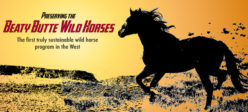By 2015, uncontrolled growth of the Beaty Butte herd grew to about 1500 horses which had done tremendous damage to this high desert rangeland. This HMA was always supposed to be limited to no more than 250 wild horses.
 For more detail use link below: specifically pages 16-31 for map and photo descriptions..
For more detail use link below: specifically pages 16-31 for map and photo descriptions..
The area contains the largest continuous tract of Sagebrush Focal Area-designated land in Oregon, which is the highest priority for maintaining greater sage-grouse habitat. To aid in the conservation and recovery of the greater sage-grouse, as well as to manage healthy wild horses on healthy public rangelands, the BLM’s goal is to maintain the wild horse herd in the HMA at the appropriate management level of 100-250 animals.
 High School art teacher and photographer, Jonne Goeller, and her husband, Steve, have enjoyed camping and photographing the wildlife and wild horses in the Beaty Butte area on and off for almost 30 years.
High School art teacher and photographer, Jonne Goeller, and her husband, Steve, have enjoyed camping and photographing the wildlife and wild horses in the Beaty Butte area on and off for almost 30 years.
Visitors to this extremely remote wild mustang Herd Management Area (HMA) and cattle range are few and far between. The Goeller’s took photos of the horses, antelope, sage grouse, and other wildlife with trail cameras placed at the water holes for the last few years. These photos, taken without any political agenda, end up being an important record of how the land and waterholes were impacted by the dramatic increase in wild horse numbers to about 1500 animals in 2015, then how the land and wildlife has recovered since the removal of most of those horses. The recovery was also aided by a more normal snowpack during the winter of 2016/2017.
Jonne says, “The top of Beaty Butte is 7,918 feet. The horses really like the mountain range during the hot part of the summer, but they can be anywhere in the management unit.
What we have seen since 2013 are many defunct springs that don’t work anymore, the troughs are tipped over, and the quality of water for the wildlife isn’t what it could be. During the drought, to get to the water, I saw numerous instances of fences trampled down which were probably pushed down by animals trying to get to water. We hope to see water sources restored by securely fencing them and repairing the troughs and the piping to the troughs. Dozens of springs in the unit look like this. Almost all the springs are on private lands because years ago homesteaders came in and claimed the units with springs. We’ve been going out to eastern Oregon and Beatys Butte area for thirty years. Most of the springs used to be well maintained. Now all the cattle and wildlife have for water is the runoff into reservoirs, natural seeps, and broken, rundown water troughs.”
Pictured one of the few permanent, year round water reservoirs on the Beaty Butte range.
In the fall of 2015 when they had approximately 1500 horses, we observed that they were very skinny before they did the roundup. In many of the bands of horses, ribs were showing because there were way too many horses on the range.
They are just coming into seeps except for the reservoir. When springs have degraded to seeps, due to drought or neglect, it takes along time for every animal to get adequate water, except at reservoirs. The drought and neglect of water resources was extremely hard on this range.
The wild horses and the cattle share the range with the antelope. In 2016 we didn’t pick up big large herds of antelope on our trail cameras. This year, 2017, [with all the excess horses removed] the antelope herds were 20% larger with more little ones.
Jonne concludes, “I think the health of all animals and birds on the range, including the cattle, needs to be the number one priority. In 2015 and 2016, there were just way too many horses, not enough feed, not enough water, ribs were showing on a third of the horses. They just didn’t look very healthy. The range was grazed off.
In conclusion Jonne said, “After the roundup in the fall of 2016, there was major recovery of the feed to the point that some of the horse trails were almost grown shut. We navigate the horse trail system, we know it well, as that is how we hike cross country. In the fall of 2017 there was way more feed for everybody…even the sage grouse looked fat and happy!”
“Better range and water management, along with controlling wild horse herd size, could have significant benefits for every animal, bird, and human using the Beaty Butte HMA.” – Jonne’s last words






